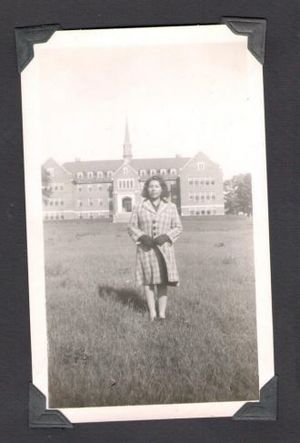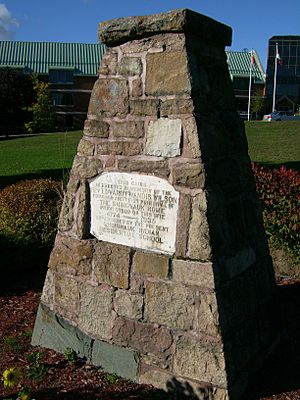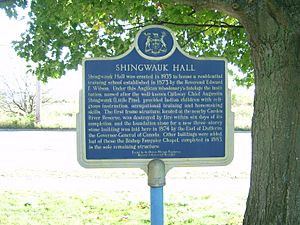Shingwauk Indian Residential School facts for kids
Quick facts for kids Shingwauk Indian Residential School |
|
|---|---|

Shingwauk Hall, now the central building of Algoma University.
|
|
| Type | Residential school |
| Location | Sault Ste Marie, Ontario |
| Built |
|
| Architect | Roland Gurney Orr |
| Owner | Algoma University, Shingwauk Education Trust |
The Shingwauk Indian Residential School was a special type of boarding school for First Nations, Métis, and Inuit children in Canada. It operated in Sault Ste. Marie, Ontario, from 1873 to 1970. The school was run by the Anglican Church of Canada and the Government of Canada.
These schools were part of a system that aimed to change Indigenous children's cultures and ways of life. Today, the building known as Shingwauk Hall, built in 1935, is the main building of Algoma University.
Contents
History of Shingwauk School
Early Schools in Sault Ste. Marie
Before the Shingwauk School was built, there were smaller mission schools in Sault Ste. Marie. In the 1830s, a leader named Chief Shingwauk traveled a long way to ask the government for help. He wanted to create a 'Teaching Wigwam' in Garden River for his people.
In 1833, an Anglican missionary named William McMurray arrived. He helped start a day school in Sault Ste. Marie. Children from Garden River First Nation attended this school. It received money from both the government and the Anglican Church. Another day school was opened in the Garden River community in 1870.
The First Shingwauk Industrial Home
In 1871, another Anglican missionary, Reverend Edward Francis Wilson, came to Garden River First Nation. He worked with the Anglican Church, the government, and local First Nations people to raise money for a new school.
Thanks to his efforts, the first Shingwauk Industrial Home opened on September 22, 1873. It was located in Garden River First Nation. Sixteen boys were the first students. Sadly, just six days after it opened, the school building was completely destroyed by fire.
Building the Shingwauk Home
After the fire, Reverend Wilson bought a large piece of land in Sault Ste. Marie. This land is now at 1520 Queen Street East. On July 31, 1874, a special ceremony took place. The Earl of Dufferin, who was the Governor General of Canada, laid the first stone for the new building.
The new Shingwauk Home officially opened on August 2, 1875, with 50 students. At first, the school did not have running water or electricity. This building was later replaced by the New Shingwauk Hall in 1935.
The Wawanosh Home for Girls
The first Shingwauk Home was not built to have both boys and girls living there. So, a separate school for girls, called the Wawanosh Home, was started. It was about five kilometers away in Tarentorus.
The Wawanosh Home opened in 1877 with ten girl students. More construction happened until 1879, and then enrollment grew to 15 students. The government gave $600 each year to help with the girls' education. The Anglican Church managed the Wawanosh Home, and Reverend E.F. Wilson, the Shingwauk Home principal, oversaw it.
By the mid-1880s, Wilson decided it would be better if the girls were at the same location as the boys. So, a special wing for girls was added to the Shingwauk Home on Queen Street. In 1900, the Wawanosh Home officially moved to the Shingwauk site.
The old Wawanosh Home building was later bought by the Children's Aid Society of Algoma. It was used as a shelter from 1912 to 1955. Today, the Sault Ste. Marie Legion Hall is located on that site.
The New Shingwauk Indian Residential School
In 1935, the new Shingwauk Hall opened right behind the old building on the Shingwauk site. This new building was much bigger, designed for 140 students. It had modern features like running water and electricity, which the old Shingwauk Home did not have.
Roland Gurney Orr, the main Architect for the Department of Indian Affairs, designed the New Shingwauk Hall. It was built in a style called Collegiate Gothic. Many residential schools and government buildings across Canada looked similar to Shingwauk Hall. For example, schools in Edmonton, Alberta, Kamloops, and St. Paul's were built with similar plans in the 1920s.
The Shingwauk School was closed by the Department of Indian Affairs in June 1970. In 1971, Algoma University College moved onto the Shingwauk site. Today, Shingwauk Hall is the main building for Algoma University.
Until April 1, 1969, the Missionary Society of the Church of England operated all versions of the Shingwauk Residential School. From April 1, 1969, until its closure on June 30, 1970, the Government of Canada took over running the school. However, the land itself stayed with the Diocese of Algoma. This was because of an earlier agreement that said the land would go back to the Diocese when the government stopped using it.
School Chapel
The Bishop Fauquier Memorial Chapel is the only building left from the very early days of the Shingwauk School. Its construction started in 1881 and finished in 1883. Edward Francis Wilson, who also designed it, oversaw the building process.
The chapel mixes Gothic and Tudor architectural styles. It was built using sandstone found right there in Sault Ste. Marie, Ontario. Bishop Edward Sullivan of the Anglican Diocese of Algoma officially dedicated it on August 29, 1883.
The chapel is named after Bishop Frederick Dawson Fauquier. He was the first Bishop of the Anglican Diocese of Algoma. When the Shingwauk Indian Residential School was open, students and staff went to weekly services at the chapel. It was also used for weddings, funerals, and other special events.
In 1981, the City of Sault Ste. Marie recognized the chapel as a heritage site. This means it is an important historical building.
School Cemetery and Student Deaths
The Shingwauk Memorial Cemetery is where over 120 students and staff from the Shingwauk Indian Residential School are buried. It is located in a wooded area northeast of Shingwauk Hall, next to Snowdon Park. Many of these graves do not have names on them.
During the time the residential school was open, staff and church officials received stone headstones. However, most students' graves were marked with wooden crosses. Because of damage and the wood rotting away, none of these wooden crosses are left today.
The land for the cemetery was given to the Shingwauk School by William Stratton. He owned the farm next to the school. Bishop Frederick Dawson Fauquier officially dedicated the cemetery on June 2, 1876. The stone wall around the older part of the cemetery was built by the students of the Shingwauk School.
In 1988, the Children of Shingwauk Alumni Association and other survivors of the school put up a monument. This monument remembers everyone buried in the cemetery. A list of known individuals buried there was created to go with this monument. Copies are kept in the Bishop Fauquier Memorial Chapel and the Shingwauk Residential Schools Centre at Algoma University.
In 2021, the Shingwauk Residential Schools Centre updated the burial list. They added more names of those buried in the cemetery. Deaths at the Shingwauk Residential School are also recorded in the National Memorial Register. This register was created by the National Centre for Truth and Reconciliation.
After unmarked graves were found at the Kamloops Indian Residential School in 2021, a search for unmarked burials at the Shingwauk School began in September 2021.
Life at Shingwauk School
At its busiest, over 150 students lived and attended the Shingwauk Indian Residential School. During the early years, the school followed an "industrial school" model. This was similar to manual labor colleges in the US. In these schools, students would go to classes for half the day. For the other half, they would do manual work around the school.
The Shingwauk Home was designed to be self-sufficient. It had a fully working farm. Much of the work students did was related to running the farm and the school every day.
Like many other residential schools across Canada, living conditions at Shingwauk were often poor. The quality of education many children received was not good. Many survivors from Shingwauk have shared stories about difficult experiences. They also talk about the long-lasting effects of the assimilation process that happened at residential schools. This process tried to make Indigenous children forget their own cultures and adopt Canadian ways.
In later years, many students at the Shingwauk Home lived there but went to nearby public elementary and high schools. Anna McCrea Public School and Sir James Dunn Collegiate and Vocational School were built on the original Shingwauk site in the 1950s. This was part of a government plan to integrate students into public schools.
School Principals
| Principal Name | Years |
|---|---|
| Rev. E.F. Wilson | 1873-1893 |
| Rev. James Irvine | 1893-1894 |
| James Lawler | 1894 |
| George Ley King | 1897-1906 |
| Rev. Benjamin P. Fuller | 1910-1929 |
| Rev. Charles F. Hives | 1929-1941 |
| Rev. Canon Arthur E. Minchin | 1941-1948 |
| Rev. Douglas C. Wickenden | 1948-1954 |
| Rev. Roy Phillips | 1954-1966 |
| Robert Martin | 1964-1965 |
| David Lawson | 1966-1967 |
| Alan Wheatley (administrator) | 1967-1968 |
| Rev. Noel Goater (administrator) | 1968-1970 |
Memorials and Recognition
There are several memorials on the Shingwauk Indian Residential School Site. They help people remember its history and the experiences of those who attended.
- A stone monument honors the school's founder, Rev. E.F. Wilson. It is on the front lawn of Algoma University. It was built using stones from the original principal's house.
- Behind the Wilson monument is another one put up by the Children of Shingwauk Alumni Association. This monument was placed in August 2012. It remembers all who attended residential schools across Turtle Island (North America). It especially honors those who never returned home. The plaque is surrounded by symbols of the Seven Grandfather Teachings. This monument was part of a larger event by the Truth and Reconciliation Commission of Canada.
- The Shingwauk Memorial Cemetery also has a stone marker. It was put there by the Children of Shingwauk Alumni Association and the cemetery committee. It remembers everyone buried in the cemetery.
- A special bench is also in the Shingwauk Memorial Cemetery. It says, "In Memory of Shingwauk Residential School. Students Remembering Students." It was placed there in 2012.
- An Ontario Heritage Foundation plaque explains the history of the Shingwauk site. This marker is outside the Bishop Fauquier Chapel. The chapel is the only original building left from the school's early years.
- The Shingwauk Residential School site has also received two special markers from the Assembly of First Nations. These markers are for the Shingwauk Indian Residential School and the Wawanosh Indian Residential School. One marker is currently displayed at the Shingwauk Residential Schools Centre. The permanent location for these markers is still being decided.
- On August 3, 2018, an exhibition called Reclaiming Shingwauk Hall opened on the site. This exhibition honors the experiences of residential school survivors. It also teaches the public about the history of the site.
- In April 2021, the Shingwauk Residential School site was named a national historic site. This was done by the Historic Sites and Monument Board of Canada.
See also





